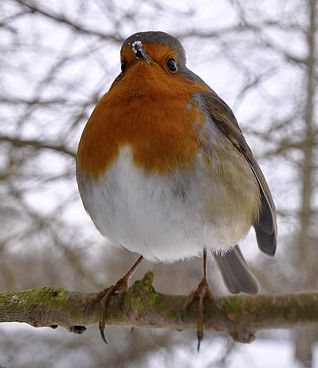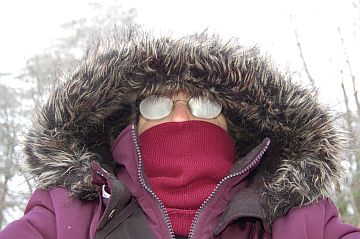Keeping Warm in Cold Weather
Hypothermia is an ever present danger in the mountains, so keeping warm in cold weather is critical.
Basically what you need to remember, for dressing properly in cold weather, is the Three W's: Wicking, Warmth, and Windproof. OK, number one, Wicking. This is the first layer you put on against your skin. The purpose of this layer is to pull moisture away from your body so that you stay dry. Also this sees to it that evaporation (which causes the air temperature to drop) happens away from the skin. This layer should be fairly thin, and made of wool, polyester or polypropylene.

OK, next is the Warm layer. The whole theory behind this layer is to create loft and trap air. This air is actually the insulator and loft creates space for the air to be trapped. This is why birds fluff up their feathers on a cold day; they are creating more loft to trap warm air.
OK, obviously goose down is a good choice for this layer because it has excellent loft and tons of little places to trap air. However, when it gets wet it lays flat and loses all its insulating power. But in real cold, dry weather, down is the insulation of choice.
Some other good ones for this layer are wool and polyester fleece. Both of these have similar insulating properties to each other, and retain a good amount of these properties when wet. Also I like to use a 100% acrylic knit sweater for this layer, and remember you can put on as many fleece (or the other materials mentioned) jackets or sweaters as you like for this layer; but usually one or two are sufficient for keeping warm.
Last but not least is the Windproof Layer, your outermost layer. You don't want to have all those nice little pockets of warm air trapped amongst the fibers of fleece, just to have the wind blow them away, so let's put on that windproof layer.
This layer should ideally be windproof/waterproof and breathable. Breathable means it lets the evaporating moisture out but doesn't let the rain in. This layer is usually, but not always, just a shell, parka-type jacket with no insulation. A good example of material with these properties is Gore-tex, but many outerwear manufacturers have their own alternative to this.
All of these basics hold true with hands and feet as well. However, your boots usually become your windproof layer on your feet. For your head, just a single warm layer will usually do; you don't need the wicking layer and your jacket should provide a hood for the windproof layer. Always cover your head in cold weather, as a great deal of heat will be lost otherwise.
Another thing that is important (if you want to keep those little digits from freezing) is to keep your body core temperature sufficiently warm. If your vital organs are warm enough, then your body will let warm blood go out to the extremities. Otherwise it will hold that warm blood in the core, leaving your fingers, toes and nose cold. That is why these are the most susceptible to frostbite.

So remember, for keeping warm in real cold weather, cover all exposed skin, put on a few extra warm layers on the torso area, and have a thermos of your favorite HOT beverage with you to drink periodically, to keep that core warm because if you don't then the vital organs get stingy with that warm blood and you get cold (and maybe even frostbitten) hands and feet.